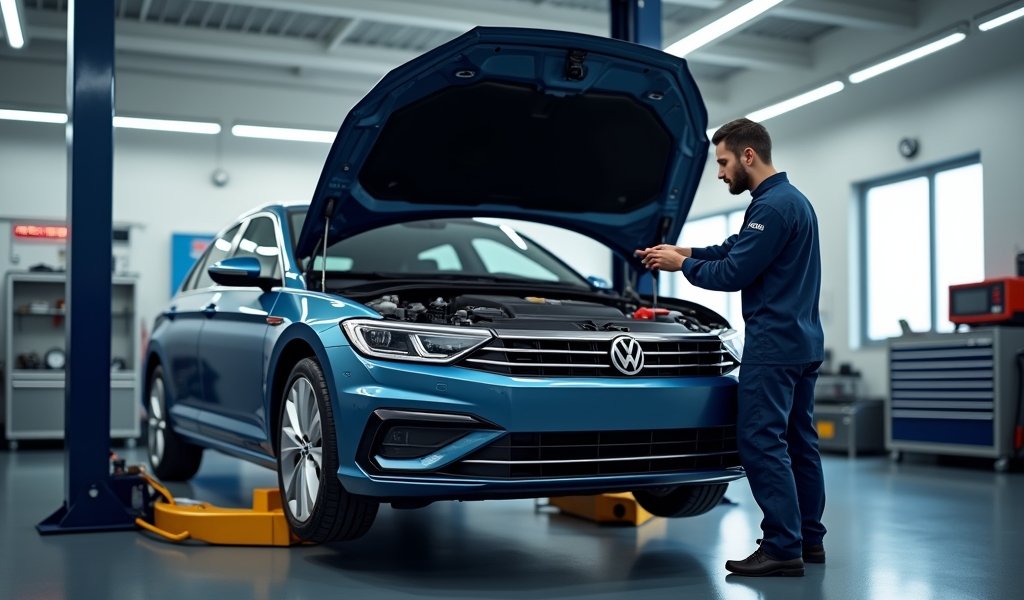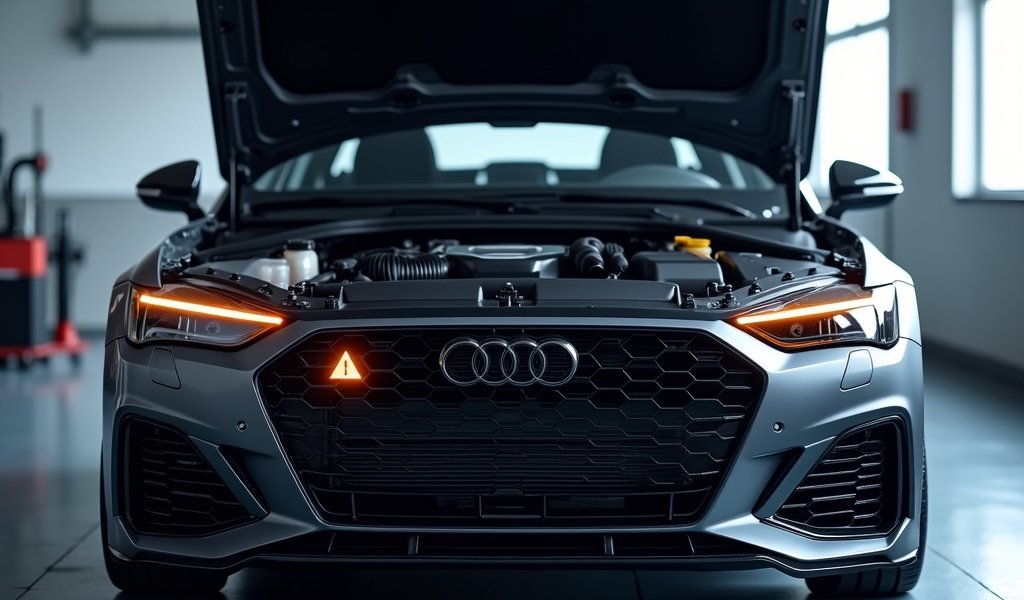Overview
This article provides a detailed guide on responding to a vehicle’s coolant temperature warning light, covering causes (from low coolant levels to faulty thermostats), immediate actions, diagnostic methods, repair options, and preventative maintenance strategies. It emphasizes that this warning requires immediate attention to avoid severe engine damage, with specific steps for both DIY repairs and situations that warrant professional assistance.
Table of Contents
- What Is the Coolant Temperature Warning Light?
- Common Causes of Coolant Temperature Warning Light
- Immediate Actions When the Warning Light Appears
- Diagnosing Coolant Temperature Issues
- Fixing Common Coolant Temperature Problems
- Preventative Maintenance to Avoid Coolant Issues
- When to Seek Professional Help
- Conclusion
- Frequently Asked Questions
What Is the Coolant Temperature Warning Light?
The coolant temperature warning light is your vehicle’s way of waving a red flag when engine temperatures are climbing into the danger zone. This little dashboard indicator might look like a thermometer floating in water or simply appear as a temperature gauge that’s moved into the red section. When this light illuminates, it’s signaling that your engine coolant has exceeded normal operating temperatures, typically around 220-230°F (104-110°C).
Unlike some dashboard warnings that you might be able to drive with temporarily, the coolant temperature warning light demands immediate attention. Your engine relies on a precise temperature balance to function properly, and when that balance is disrupted, critical engine components can sustain permanent damage within minutes—not hours or days.
As a mechanic who’s witnessed the aftermath of ignored temperature warnings, I can tell you that addressing this issue promptly isn’t just about saving repair costs (though that’s certainly a benefit). It’s about preventing a situation where you might find yourself stranded with an overheated engine or, worse, facing a complete engine rebuild due to warped cylinder heads or a cracked engine block.
Common Causes of Coolant Temperature Warning Light
When your coolant temperature warning light decides to join your morning commute, several culprits might be responsible. Let’s examine the most common causes that I encounter daily in my shop:
Low coolant level is often the simplest explanation. Your cooling system might be gradually losing coolant through a small leak, or perhaps it’s been a while since the system was topped up. The engine coolant temperature sensor detects when there’s not enough fluid circulating to properly cool your engine.
A malfunctioning thermostat can also trigger the warning light. The thermostat regulates coolant flow through the engine, and if it’s stuck closed, coolant can’t circulate properly, causing localized overheating that quickly spreads throughout the engine.
Cooling system leaks present another common issue. These can occur in radiator hoses, the radiator itself, the water pump, or even the engine block. According to a CarMD Vehicle Health Index report, cooling system issues account for about 6% of check engine light repairs.
A failing water pump might also be the villain. This critical component circulates coolant throughout the engine, and when it begins to fail, cooling efficiency drops dramatically. The water pump is driven by either the timing belt, serpentine belt, or an electric motor, depending on your vehicle.
Don’t overlook a clogged radiator or radiator cap problems. Over time, radiators can become blocked with mineral deposits or debris, restricting coolant flow. Similarly, a radiator cap that isn’t maintaining proper system pressure can lower the boiling point of your coolant, leading to overheating.
Finally, a faulty cooling fan can cause temperature spikes, particularly in stop-and-go traffic when there’s no natural airflow through the radiator. Whether it’s an electric fan with a bad relay or motor, or a mechanical fan with a broken clutch, the result is the same: inadequate cooling at low speeds.

Immediate Actions When the Warning Light Appears
When that coolant temperature warning light illuminates, consider it an emergency situation that requires immediate action. Here’s what you should do, based on my years of experience helping drivers through this predicament:
First, safely pull over as soon as possible and turn off the engine. Continuing to drive with an overheating engine can cause catastrophic damage in mere minutes. Find a safe location away from traffic and shut down the engine to prevent further heat buildup.
Next, resist the urge to immediately open the hood or coolant cap. Modern cooling systems operate under pressure, with coolant temperatures potentially exceeding 230°F. Opening the system while hot can result in serious burns from escaping steam and fluid. Wait at least 30 minutes for the engine to cool down.
While waiting, turn on your heater to maximum. This might seem counterintuitive, but the heater core acts as a secondary radiator, helping to draw heat away from the engine. Just be prepared for some uncomfortably warm air in the cabin.
Once the engine has cooled sufficiently (temperature gauge has moved to normal or the hood is cool enough to touch with bare hands), you can carefully open the hood to inspect for obvious issues:
- Look for coolant leaks under the vehicle or around the engine bay
- Check if coolant is visible in the overflow tank
- Inspect for any disconnected or damaged hoses
- Listen for unusual sounds like hissing (indicating a pressure leak)
If you have coolant available and notice the reservoir is low, carefully add coolant to the proper level. Never pour cold coolant into a hot engine as the thermal shock can crack your engine block. If you don’t have coolant, water can work as a temporary measure to get you to a service center, but proper coolant should be added as soon as possible.
Remember, these are emergency measures. After experiencing an overheating episode, have your vehicle properly inspected by a qualified technician, even if these temporary fixes seem to resolve the issue. Engine overheating causes can be complex and may indicate underlying problems that need addressing.
Diagnosing Coolant Temperature Issues
Before diving into repairs, it’s crucial to accurately diagnose what’s causing your coolant temperature warning light to illuminate. Here’s how I approach diagnostics in my shop, with some steps you can perform yourself:
Begin with a thorough visual inspection of the entire cooling system. Look for obvious leaks, damaged hoses, or signs of coolant splashed around the engine bay. Pay particular attention to connection points and the bottom of the radiator, which are common leak sources.
Next, check your coolant level when the engine is cold. Low coolant is often the simplest explanation for overheating. If the level is consistently dropping, you definitely have a leak that needs addressing. Don’t forget to examine the quality of the coolant—discolored, rusty, or oily coolant indicates other problems that need attention.
Inspect your radiator hoses thoroughly, both visually and by feel. A good hose should be firm yet slightly flexible. Hoses that feel too soft, too hard, or have visible cracks need replacement. Also check for any collapsed hoses during operation, which might indicate a vacuum problem in the cooling system.
Testing your thermostat is relatively straightforward. Start with a cold engine and monitor the temperature gauge as you drive. A properly functioning thermostat should allow the engine to warm up to operating temperature relatively quickly (typically 5-10 minutes under normal conditions) and then maintain a steady temperature. If your engine warms up extremely slowly or too quickly, the thermostat may be stuck open or closed, respectively.
For a more definitive test of your cooling system’s integrity, consider a pressure test. Professional shops use a cooling system pressure tester, but you can sometimes rent these tools from auto parts stores. The test involves pressurizing the cooling system to check for leaks that might not be visible during normal operation.
Finally, verify your coolant temperature sensor and gauge are working correctly. An inaccurate sensor can trigger false warnings or, worse, fail to warn you of actual overheating. Most modern vehicles store diagnostic trouble codes that can be retrieved with a scanner to help identify sensor issues.
According to the National Highway Traffic Safety Administration, cooling system failures are among the top causes of vehicle breakdowns. Taking the time to properly diagnose the issue not only saves you money on unnecessary parts but also prevents the compounding damage that can occur from misdiagnosis.
Fixing Common Coolant Temperature Problems
Now that we’ve identified the potential culprits, let’s roll up our sleeves and discuss how to fix these coolant temperature issues. I’ll walk you through solutions for the most common problems, from simple DIY fixes to those that might require professional assistance.
For low coolant levels without an obvious leak, topping up your coolant reservoir to the appropriate mark may resolve the warning light temporarily. Use the correct coolant type for your vehicle—mixing incompatible coolants can cause more problems than it solves. The owner’s manual specifies the right coolant, but if you’re unsure, a 50/50 mix of the correct coolant type and distilled water is generally safe.
If you’ve identified a leaking hose, replacement is straightforward and relatively inexpensive. Ensure the engine is completely cool, drain the cooling system to below the level of the leak, then remove the hose clamps and the old hose. Install the new hose with fresh clamps, refill the system, and check for leaks after the engine reaches operating temperature.
Replacing a thermostat requires a bit more mechanical aptitude but remains within DIY territory for many. The thermostat housing is typically located at the engine end of one of the main radiator hoses. After draining some coolant, remove the housing bolts, replace the thermostat (ensuring the spring side faces the engine), use a new gasket or sealant as specified, and reassemble carefully.
A clogged radiator often requires professional flushing or replacement. However, you can perform a basic radiator flush at home using commercial flush solutions and following the instructions carefully. This sometimes resolves minor clogging issues and can improve cooling system efficiency.
For water pump replacement, the complexity varies greatly by vehicle model. Some pumps are external and relatively accessible, while others are driven by the timing belt and require significant disassembly to reach. Unless you’re experienced with automotive repair, water pump replacement is best left to professionals.
If your electric cooling fan isn’t running when it should, check the fuses first—this is the simplest potential fix. If fuses are intact, the issue might be a bad temperature switch, fan relay, or the fan motor itself. Diagnosis typically requires electrical testing equipment and knowledge of your vehicle’s cooling fan circuit.
After any cooling system repair, proper bleeding of air from the system is critical. Air pockets can cause localized overheating and trigger warning lights even when everything else is functioning correctly. Many vehicles have specific bleeding procedures outlined in the service manual.

Preventative Maintenance to Avoid Coolant Issues
An ounce of prevention is worth a pound of cure—especially when it comes to your vehicle’s cooling system. Regular maintenance can help you avoid the stress and expense of dealing with a coolant temperature warning light in the first place. Here’s my professional advice on keeping your cooling system in top shape:
Schedule regular coolant flushes according to your vehicle’s maintenance schedule, typically every 30,000 to 60,000 miles. Fresh coolant provides optimal corrosion protection and heat transfer properties. As coolant ages, it becomes more acidic and loses its ability to prevent corrosion within the cooling system.
Inspect your cooling system components visually at least twice a year. Look for signs of leaks, worn hoses, or corrosion. Pay special attention to hose connections and the condition of all rubber components, which degrade over time regardless of mileage.
Keep an eye on your temperature gauge during normal driving. Being familiar with your vehicle’s normal operating temperature helps you spot potential issues before they trigger warning lights. Most vehicles should maintain a fairly consistent temperature once warmed up, regardless of driving conditions.
Consider replacing your thermostat preventatively when doing other cooling system work. As a relatively inexpensive component that can cause major problems when it fails, many mechanics recommend replacing it during coolant flushes or other cooling system maintenance, particularly on higher mileage vehicles.
Test your coolant’s condition and freeze protection annually. Inexpensive coolant test strips or a refractometer can measure the coolant’s pH level and freeze protection. Coolant that’s too acidic accelerates corrosion within the cooling system.
Don’t overlook your radiator cap. This seemingly simple component maintains proper system pressure, which raises the boiling point of your coolant. A cap that doesn’t maintain the specified pressure can cause overheating even when everything else is working correctly. Replace it every few years or if it shows any signs of wear or leakage.
Address small problems before they become big ones. That minor leak or occasional temperature spike might seem manageable now, but cooling system issues rarely resolve themselves and typically worsen over time. Addressing minor issues promptly is almost always less expensive than dealing with major overheating damage.
When to Seek Professional Help
While I’m a big advocate for DIY vehicle maintenance when appropriate, there are certain coolant system issues where professional intervention is the wisest choice. Here’s when you should consider putting down the wrench and calling a trusted mechanic:
If your vehicle has repeatedly overheated despite your best troubleshooting efforts, it’s time for professional diagnostics. Intermittent or complex cooling issues often require specialized testing equipment and expertise to properly diagnose. Modern vehicles have increasingly complex cooling systems with multiple control modules and sensors that can be difficult to troubleshoot without proper equipment.
When you suspect internal engine damage from overheating, seek professional help immediately. Signs include white smoke from the exhaust, milky oil, or bubbling in the coolant reservoir (indicating combustion gases entering the cooling system). These symptoms suggest head gasket failure, warped cylinder heads, or even cracked engine blocks—all serious issues requiring professional repair.
If your vehicle has an automatic transmission cooler integrated into the radiator, and you suspect coolant has contaminated the transmission fluid (or vice versa), professional assistance is crucial. This cross-contamination can cause catastrophic damage to your transmission if not addressed properly.
When coolant repairs involve disturbing the timing belt or chain, professional installation is strongly recommended. Improper timing belt installation can result in severe engine damage, and the labor to access these components often makes DIY attempts impractical.
If your vehicle has had the cooling system serviced recently and is now experiencing issues, return to the shop that performed the work. There may be warranty considerations, and they’ll be familiar with what was done previously. Sometimes seemingly unrelated repairs can affect the cooling system in ways that aren’t immediately obvious.
Remember that professional mechanics have access to manufacturer service bulletins and specialized knowledge about common issues for your specific vehicle model. According to AAA’s research, cooling system failures are among the top causes of serious mechanical breakdowns. The cost of professional diagnosis is often justified by avoiding more extensive damage.
Conclusion
When that coolant temperature warning light illuminates on your dashboard, it’s more than just an annoyance—it’s your vehicle communicating a potentially serious issue that deserves immediate attention. Throughout this guide, we’ve explored the causes, diagnostic approaches, and solutions for coolant temperature warning lights, equipping you with the knowledge to address these issues confidently.
Remember that your vehicle’s cooling system is a complex network of components working in harmony to keep your engine operating at its optimal temperature. From the humble radiator cap to the water pump, thermostat, and radiator itself, each part plays a vital role in preventing overheating and the costly damage it can cause.
Whether you choose to tackle some of these repairs yourself or seek professional assistance, understanding the fundamentals of your cooling system helps you make informed decisions about your vehicle’s maintenance and repair. Regular preventative maintenance remains your best defense against coolant temperature issues, potentially saving you thousands in avoidable repairs.
The next time you see that coolant temperature warning light, you’ll be prepared to respond appropriately—protecting both your vehicle and your wallet from the consequences of engine overheating. Stay cool on the road, and remember that addressing cooling system issues promptly almost always results in simpler, less expensive repairs.
Frequently Asked Questions
Can I drive with the coolant temperature warning light on?
No, you should never continue driving with the coolant temperature warning light illuminated. Pull over safely, turn off the engine, and allow it to cool down to prevent potential engine damage.
How long does it take to fix a coolant temperature warning light issue?
Repair times vary widely depending on the underlying cause. Simple fixes like topping up coolant might take minutes, while complex repairs like water pump replacement could require several hours.
What’s the average cost to fix cooling system problems?
Costs range from under $20 for a DIY thermostat replacement to $1,500+ for major repairs involving the water pump or radiator replacement. The national average for professional coolant system repairs is approximately $300-600.
Can weather affect my vehicle’s cooling system?
Yes, extreme temperatures can stress your cooling system. Hot weather increases cooling demands, while cold weather can mask existing issues by naturally helping the engine run cooler.
How often should coolant be replaced?
Most manufacturers recommend coolant replacement every 30,000-60,000 miles. However, check your owner’s manual for the specific interval recommended for your vehicle model.

